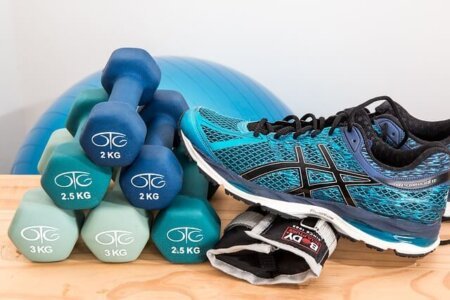Many people believe that building muscle requires lifting heavy weights, but recent research shows that you can achieve muscle growth using lighter weights with the right approach. High-repetition resistance training, where you lift lighter weights for more reps, can be just as effective for stimulating muscle hypertrophy.
This method emphasizes muscle fatigue and time under tension, helping to create the metabolic stress needed for muscle growth. Whether you are looking to reduce injury risk, improve joint health, or add variety to your routine, gaining muscle with lighter weights is a viable and beneficial strategy.
You can gain muscle using lighter weights, and it is a valid approach known as “high-repetition resistance training.” Traditionally, people associate muscle growth with lifting heavy weights for low repetitions, but recent research has shown that lighter weights can also stimulate muscle hypertrophy if used correctly.
The key lies in pushing your muscles to fatigue, even with lighter weights.
When lifting lighter weights, the goal is to perform more repetitions—typically in the range of 15-20 or even higher—until your muscles are fully fatigued. This creates a metabolic stress in the muscle, which promotes muscle growth by increasing the demand on muscle fibers, especially the smaller, slow-twitch fibers, which are often underutilized in heavier, low-rep lifting.
By going to or near failure, you trigger similar muscle growth signals as with heavy weights. The advantage of lighter weights is that they can reduce the risk of injury and improve joint health, especially for those with joint issues.
High-repetition training with lighter weights can also enhance muscular endurance and improve the efficiency of your cardiovascular system.
By prolonging time under tension (TUT), which is the total time your muscles are working during a set, you create greater metabolic stress, which plays a key role in muscle hypertrophy. Moreover, the lower load places less strain on connective tissues and tendons, which can be particularly beneficial if you are recovering from an injury or prefer a more sustainable, long-term training approach.
Incorporating this method into your routine can offer variety and allow you to keep progressing without the wear and tear that heavy lifting can sometimes cause.
However, like any workout, nutrition and recovery remain essential parts of the equation. While using lighter weights, focusing on progressive overload is still important—gradually increasing reps, sets, or weight over time helps to continually challenge your muscles, leading to growth.
YOU CAN BUILD MUSCLE USING LIGHTER WEIGHTS, BUT THERE ARE SOME DIFFERENCES COMPARED TO HEAVY WEIGHT TRAINING.
Studies suggest that if you are pushing your muscles to fatigue, you can achieve similar muscle hypertrophy (growth) with lighter weights as you would with heavier weights. However, the pathway to that growth differs, and there can be some noticeable distinctions.
Using lighter weights typically involves higher repetitions, which places more focus on metabolic stress and endurance.
This can lead to muscle growth, but the muscle size increase may be slightly less pronounced compared to heavy weight training. Heavier weights tend to activate more fast-twitch muscle fibers, which are associated with greater muscle size and strength gains.
In contrast, lighter weights primarily target slow-twitch fibers, which are more fatigue-resistant but do not contribute as much to sheer muscle size.
So, while lighter weights can help you build muscle, the muscles may not be as dense or “thick” as those built using heavy weights.
Additionally, lighter weight training is more likely to improve muscular endurance, whereas heavy weightlifting builds more raw strength.
The difference in size might not be dramatic, but if maximum muscle bulk is your goal, incorporating heavier weights could give you an edge. The best approach might be a mix of both light and heavy weight training, depending on your goals.
Muscular endurance and raw strength are two distinct aspects of fitness, and they serve different purposes.
Muscular Endurance refers to the ability of a muscle or group of muscles to sustain repeated contractions over an extended period without fatigue. In other words, it is about how long your muscles can continue to perform a certain task.
For example, activities like long-distance running, cycling, or high-repetition resistance training (using lighter weights) build muscular endurance. Endurance exercises typically involve working at a lower intensity but for longer durations, and they primarily engage slow-twitch muscle fibers, which are more fatigue-resistant but generate less force.
Raw Strength, on the other hand, is about how much force or weight a muscle can generate in a single, maximal effort. This is the kind of strength you develop with low-rep, high-weight exercises like powerlifting or heavy resistance training. Raw strength training focuses on maximizing the output of fast-twitch muscle fibers, which produce powerful, short bursts of energy but fatigue more quickly. Building raw strength allows you to lift heavier loads and perform tasks that require maximum effort, such as deadlifting a heavy weight or doing a single explosive sprint.
In short, muscular endurance is about sustaining effort over time, while raw strength is about producing maximum force in a short period. Both are important in different contexts: endurance is crucial for long-duration activities, and strength is key for short, intense efforts.
The type of weight training you focus on—light weights for muscular endurance or heavy weights for raw strength—should align with the specific demands of the sport you are participating in.
Different sports require different combinations of endurance, strength, power, and agility, so understanding your sport’s requirements will help you design the most effective training program.
Here is how it breaks down:
Sports that Require Muscular Endurance: If your sport involves sustained effort over a long period, such as soccer, basketball, distance running, cycling, or swimming, you will want to prioritize building muscular endurance. Lighter weights with higher repetitions will help your muscles resist fatigue, allowing you to perform at a steady intensity for longer periods. This training improves your ability to maintain form and energy throughout a game, race, or event.
Sports that Require Raw Strength and Power: Sports like football, wrestling, weightlifting, or track and field events (e.g., sprinting, shot put) demand short bursts of maximal force and power. For these activities, focusing on heavy weights with low repetitions is essential. This type of training helps build fast-twitch muscle fibers, which allow you to generate explosive movements, tackle harder, or jump higher. The goal here is to increase your maximal strength and power output.
Sports that Require a Mix of Both: Some sports require a combination of both endurance and strength. For example, in tennis, you need endurance to last through long matches, but also strength and power for explosive movements like serving or sprinting to the ball. In this case, incorporating both light and heavy weight training into your routine could be beneficial. The same applies to sports like basketball or hockey, where endurance, agility, and power are all crucial components.
By tailoring your weight training to the specific needs of your sport, you will improve your performance more effectively and build the kind of fitness that directly supports your athletic goals.
IF YOU’RE WORKING OUT FOR GENERAL FITNESS AND NOT SPECIALIZING IN A PARTICULAR SPORT, HIGH-REP TRAINING WITH LIGHTER WEIGHTS CAN DEFINITELY HELP YOU ACHIEVE A FIT, TONED, AND WELL-DEFINED PHYSIQUE FOR BOTH MEN AND WOMEN.
This type of training emphasizes muscular endurance and lean muscle growth, which can lead to a more aesthetic, athletic appearance without necessarily adding bulk.
Here’s why high-rep training can be effective for overall fitness:
Lean Muscle Development: High-repetition, lighter-weight exercises help build lean muscle. This results in a more defined and toned look, as opposed to the larger, bulkier muscles that heavy weightlifting tends to create. Many people find this physique appealing because it creates a fit appearance without excessive muscle mass.
Fat Burning: High-rep training also helps burn more calories during a workout, which can contribute to fat loss. By maintaining a higher level of intensity over a longer period, your body uses more energy, helping you stay lean and improving muscle definition as the fat is reduced. This is especially effective when combined with cardiovascular exercises and a balanced diet.
Improved Muscle Endurance and Definition: Repeatedly working muscles to fatigue through higher reps improves muscle endurance and gives your muscles that “toned” look. It helps build a good foundation of strength, flexibility, and durability without putting too much strain on joints and tendons, which can be particularly useful for those focused on long-term health and fitness.
Balanced Physique: High-rep, lower-weight routines allow you to target different muscle groups evenly, promoting a balanced, functional physique. Whether your goal is to have well-defined arms, a strong core, or toned legs, this type of training works well for sculpting all areas of the body without overdeveloping any single muscle group.
For men and women alike, high-rep resistance training can lead to a fit, toned body, with enough strength to handle everyday activities while looking great. It is a sustainable, safe way to stay in shape and is often more approachable than heavy lifting, especially for those who prefer a lean, athletic appearance rather than a bulky one.
TO EFFECTIVELY BUILD MUSCLE WITH LIGHTER WEIGHTS, IT’S IMPORTANT TO STRUCTURE YOUR WORKOUTS AND RECOVERY PROPERLY. HERE’S A GENERAL GUIDELINE:
Frequency
Aim to work out 3 to 5 times a week. This frequency allows for enough volume to stimulate muscle growth while providing adequate recovery. If you are working out 5 times a week, consider alternating muscle groups (upper/lower body or push/pull) to allow each muscle group to recover.
Sets and Repetitions
For each body part, aim for 3 to 4 sets of 12 to 20 repetitions. This range is effective for promoting muscular endurance and hypertrophy with lighter weights. The key is to ensure you are reaching muscle fatigue by the end of each set, which maximizes the benefits of your training.
Recovery
Recovery time is crucial. Make sure to allow at least 48 hours of recovery for each muscle group before training it again. For example, if you do an upper-body workout on Monday, wait until Wednesday or Thursday before targeting those muscles again.
Example Workout Split
Here is a simple example of how you might structure your week:
- Day 1: Upper Body (3-4 sets of 12-20 reps for chest, back, shoulders, arms)
- Day 2: Lower Body (3-4 sets of 12-20 reps for quads, hamstrings, glutes, calves)
- Day 3: Active Recovery (light cardio, stretching, or yoga)
- Day 4: Full Body (3-4 sets of 12-20 reps for compound exercises like squats, push-ups, rows)
- Day 5: Core and Flexibility (focusing on core exercises and flexibility work)
- Day 6: Rest or light activity
- Day 7: Optional light workout or rest
Listening to Your Body
Always listen to your body. If you feel fatigued or sore, consider adding extra recovery days or adjusting your workout intensity. Quality of movement and proper form should always take precedence over quantity. This approach will help you build a fit and toned physique sustainably and effectively.
TO SUM IT UP
To effectively build muscle using lighter weights, it is important to structure your workout routine thoughtfully. Aiming for 3 to 5 workouts per week allows you to achieve enough volume for muscle growth while ensuring proper recovery. Each workout should include 3 to 4 sets of 12 to 20 repetitions per body part, focusing on reaching muscle fatigue by the end of each set.
This approach promotes muscular endurance and helps develop a toned, athletic physique without the bulk associated with heavy lifting.
In terms of recovery, it is crucial to allow at least 48 hours before targeting the same muscle group again. For example, if you work on your upper body one day, wait until at least a couple of days later to train those muscles again.
A sample weekly structure might include upper and lower body days, a full-body workout, active recovery, and core-focused sessions. Listening to your body is essential; prioritize quality of movement and adjust your routine as needed to maintain balance and prevent fatigue. By following this plan, you can achieve a fit and aesthetically pleasing physique while minimizing the risk of injury.
You can find more information on building muscle with lighter weights and developing a workout routine from a variety of sources:
- Fitness Websites and Blogs: Sites like Bodybuilding.com, ACE Fitness, and Healthline offer articles and guides on workout strategies, including high-rep training and muscle endurance.
- YouTube Channels: Fitness experts and trainers often share workout routines, tips, and demonstrations. Channels like Athlean-X, Jeff Nippard, and Fitness Blender provide valuable insights and workout examples.
- Books: Look for books focused on strength training and endurance, such as “StrongLifts 5×5” or “The New Rules of Lifting.” These often cover various approaches to resistance training.
- Online Courses: Platforms like Udemy or Coursera may have courses on strength training and fitness principles, which can provide a more in-depth understanding.
- Personal Trainers: If you prefer personalized guidance, consider consulting a certified personal trainer. They can create a tailored workout plan based on your goals and fitness level.
- Fitness Apps: Apps like MyFitnessPal or Strong can help you track your workouts and provide structured routines that focus on different training styles.
- Research Articles: Websites like PubMed or Google Scholar allow you to explore scientific studies on resistance training, muscle growth, and exercise physiology for more academic insights.
Exploring these resources can help you deepen your understanding and refine your approach to fitness.
If you liked this Share It!
Unleash your BOHOtude – visit BOHOtude Apparel for a selection of free-spirited apparel.














